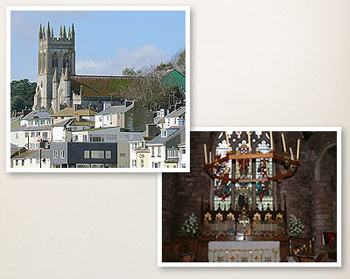
Apart from fishing, most of the other local industries were connected with
our rocks. Limestone was once quarried extensively. It was used to build
the breakwater, for houses and roads, and was sent to Dagenham to make steel
for Ford cars. It was also burnt in limekilns to reduce it to a powder which
was spread on the land in other parts of Devon as an agricultural fertiliser.
You will see the old quarries and the limekilns as you walk around the town.
Another mineral found in Brixham is ochre. This gave the old fishing boats
their "red sails in the sunset", but the purpose was to protect
the canvas from seawater, not to be picturesque. It was boiled in great
caldrons, together with tar, tallow and oak bark, the last ingredient giving
the name of barking yards to the places where the hot mixture was painted
on to the sails, which were then hung up to dry.
The ochre was also used to make a very special paint. This was invented
in Brixham in about 1845 and was the first substance in the world that would
stop cast iron from rusting. None of the well-known scientists of the day
could find a way of doing this, and, when the paint began to be made here,
it sold all round the globe. Other types of paint were made here as well,
and the works were in existence until 1961. There were iron mines at Brixham,
and for a while they produced very high quality ore but the last one closed
in 1925. Most of the sites have been built over and there are now no remains
of this once important industry.